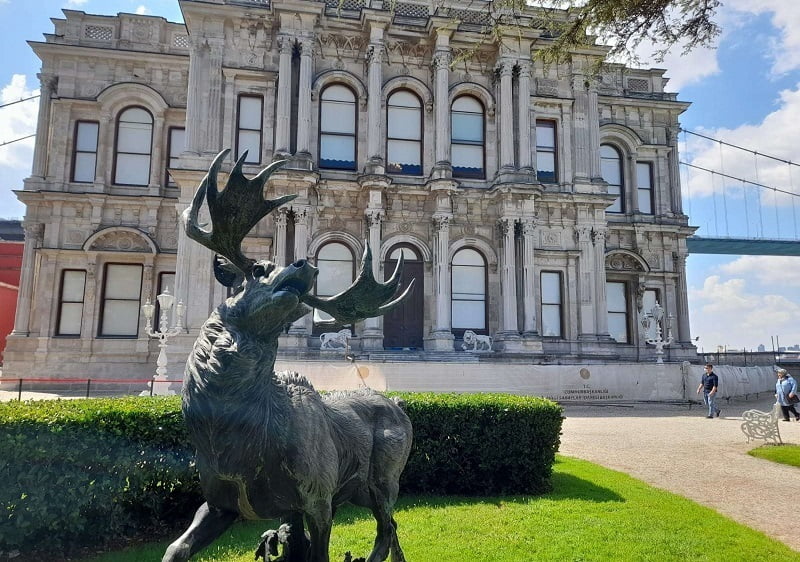
Beylerbeyi and the nearby areas have been populated continuously since the Byzantine era. On the site of multiple buildings from different eras, Sultan Mahmud II (1808–1839) had a wooden palace erected. After it was destroyed by fire in 1863 and 1865, Sultan Abdülaziz had a new palace and other buildings constructed. The Mabeyn and Harem areas of the main palace building are open to the public. The Marble Kiosk, the Stable Kiosk, where the royal horses were kept, and the Marine Kiosks are off-limits to guests, as is the Yellow Kiosk by the large pool on the upper terrace garden.
The Beylerbeyi Palace was the official summer residence and state guest house of the Ottoman Empire. There were many famous visitors who stayed at this hotel, including Franz Joseph, Emperor of Austria-Hungary (1869), Eugénie, Empress of France (1869), Nikola, King of Montenegro (1874), and German Emperor Wilhelm II. After he was removed from power, Sultan Abdülhamid II lived in Beylerbeyi Palace for the last six years of his life. He died there in 1918.
The palace’s interior, which blends Western and Eastern styles, is reminiscent of traditional Turkish houses. There are a total of 24 rooms and 6 halls spread across the palace’s three floors, not counting the basement. Egyptian straw mats cover the floors of the royal palace. Throughout the palace are pieces of art from all over the world, including Turkish Hereke carpets, French Baccarat crystal chandeliers, English, French, and Turkish clocks made at the Haliç (Golden Horn) Dockyard in Istanbul, and vases made of Chinese, Japanese, French, German, and Turkish Yldz porcelain.
Expansion with More Structures and Outdoor Space
The Marble Kiosk was constructed between 1829 and 1832 as a hunting lodge for Sultan Mahmud II; its name comes from the marble that lines its exterior walls.
The Yellow Kiosk: Situated close to the Marble Kiosk, the Yellow Kiosk has windows facing both the garden and the street. The two-story kiosk with a basement is a beautiful example of the time because of the ornate ceilings and other details inside.
This kiosk at the top of the terraced garden celebrates Ottoman traditions surrounding horses. The ceiling of the foyer is painted with scenes of horses and other animals. There are forty stalls in total, twenty on either side of the stable. The chandeliers and other light fixtures feature horse-head and eye motifs in relief.
The Beylerbeyi Palace gardens are interconnected by ramps and stairs, and the palace itself is one of the most prestigious structures of the nineteenth century. The gardens cover 70,000 square meters in total. During Sultan Abdülhamid II’s reign, he had trees such as magnolias and chestnuts planted in the imperial garden, lindens planted in the harem garden, and judas trees, the symbol of the Bosphorus, planted in the terraced gardens.
There are two marine kiosks, one belonging to the Mabeyn and the other to the Harem (presumably for use by the sultan’s mother). Those structures, which can be found in the archives under the names “tent kiosks” and “nevresm kiosks” (new design, new model), are called “novel” because of their novel structure. Both stands feature octagonal roofs covered in paintings of various animals.